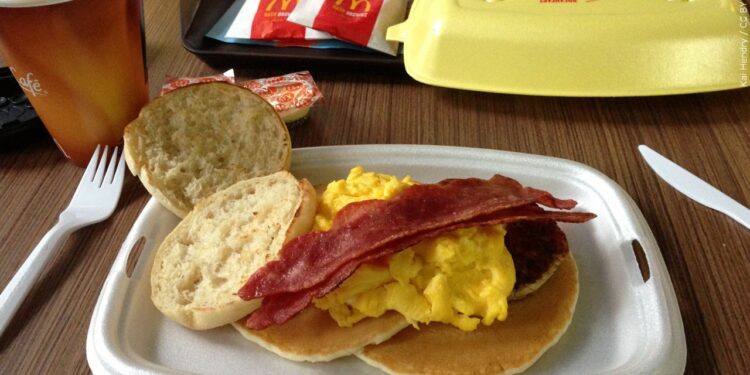(LOOTPRESS) – The cost of breakfast foods has skyrocketed in recent months, leaving many Americans rethinking their most important meal of the day. Staples like eggs, bacon, milk, coffee, and cereal have seen significant price increases due to a combination of factors, including supply chain disruptions, inflation, and extreme weather events.
What’s Driving Prices Up?
Several key factors are fueling the rising cost of breakfast foods:
- Egg Prices Soaring: Egg prices have more than doubled in some areas, driven by an ongoing avian flu outbreak that has decimated poultry populations. The U.S. Department of Agriculture reported that millions of egg-laying hens have been culled, reducing supply and pushing prices higher.
- Coffee Costs Climb: Coffee lovers are also feeling the pinch, with global coffee prices spiking due to droughts in Brazil, the world’s largest coffee producer. Shipping delays and higher labor costs have further compounded the problem.
- Dairy and Grains Affected: Milk and cereal prices have risen due to increased feed costs for livestock and disruptions in grain supply caused by geopolitical tensions, particularly the war in Ukraine. These factors have contributed to higher costs for producing and transporting breakfast essentials.
- Bacon and Meat Prices Stay Elevated: While meat prices have slightly stabilized after reaching record highs during the pandemic, pork and bacon remain expensive due to supply chain bottlenecks and higher energy costs.
Impact on Consumers
For families already stretched thin by inflation, the rising cost of breakfast foods is an added burden. A carton of eggs, which once cost under $2 in many places, can now exceed $5. Coffee prices have jumped by more than 20%, while the cost of a gallon of milk has climbed nearly 15% compared to last year.
“I’ve had to cut back on buying eggs and switch to less expensive breakfast options,” said Jennifer Morales, a mother of three in Chicago. “Even simple meals like toast and coffee are costing a lot more.”
For restaurant owners, the rising prices are just as painful. Diners and cafés have had to adjust menus and pass costs onto customers, leading to higher prices for items like omelets, pancakes, and breakfast platters.
Are Prices Likely to Drop?
Experts warn that relief may not come quickly. Ongoing challenges, such as climate change’s impact on agriculture and the uncertain resolution of global supply chain issues, mean that prices could remain high for the foreseeable future.
However, some signs of stabilization are emerging. Analysts suggest that as inflation slows and supply chains improve, costs could moderate in late 2025.
Adjusting to the New Normal
In the meantime, consumers are finding creative ways to save on breakfast foods, such as purchasing in bulk, exploring alternative options, and taking advantage of sales. For some, this means skipping certain items altogether.
The rising cost of breakfast is more than a financial issue; it’s a reminder of how interconnected global factors—from disease outbreaks to climate change—can impact even the most routine aspects of daily life. As Americans navigate this new reality, breakfast remains a costly but cherished tradition.









